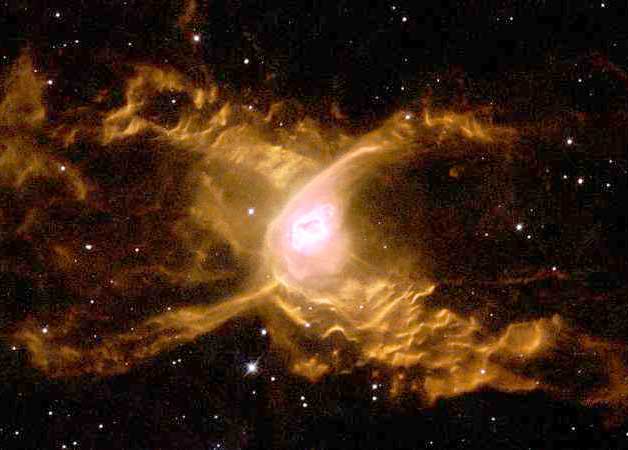Explanation: Oh what a tangled web a planetary nebula can weave. The Red Spider Planetary Nebula shows the complex structure that can result when a normal star ejects its outer gases and becomes a white dwarf star. Officially tagged NGC 6537, this two-lobed symmetric planetary nebula houses one of the hottest white dwarfs ever observed, probably as part of binary star system. Internal winds emanating from the central stars, shown in the central inset, have been measured in excess of 1000 kilometers per second. These winds expand the nebula, flow along the nebula's walls, and cause waves of hot gas and dust to collide. Atoms caught in these colliding shocks radiate light shown in the above representative-color picture. The Red Spider Nebula lies toward the constellation of Sagittarius. It's distance is not well known but estimated by some to be about 4000 light-years.
1999 2000 2001 2002 2003 2004 2005 2006 2007 2008 2009 2010 2011 2012 2013 2014 2015 2016 2017 2018 2019 2020 2021 2022 2023 2024 2025 |
Yanvar' Fevral' Mart Aprel' Mai Iyun' Iyul' Avgust Sentyabr' Oktyabr' Noyabr' Dekabr' |
NASA Web Site Statements, Warnings, and Disclaimers
NASA Official: Jay Norris. Specific rights apply.
A service of: LHEA at NASA / GSFC
& Michigan Tech. U.
|
Publikacii s klyuchevymi slovami:
Planetarnaya tumannost' - planetary nebula - NGC 6537 - tumannost' Krasnyi Pauk - Red Spider Nebula
Publikacii so slovami: Planetarnaya tumannost' - planetary nebula - NGC 6537 - tumannost' Krasnyi Pauk - Red Spider Nebula | |
Sm. takzhe:
Vse publikacii na tu zhe temu >> | |
